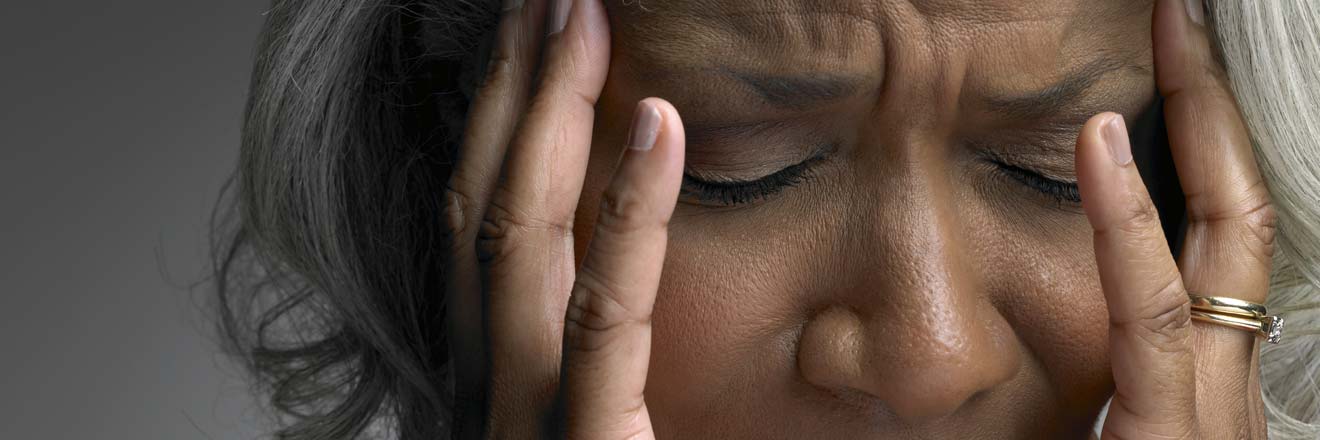Tension headaches account for nearly 90% of all headaches and are probably experiences by most people at some time during their lifetime. Tension headaches are frequently associated with fatigue, stress or hangovers. They generally respond to simple measures such as rest or over-the-counter pain medicine. A characteristic of tension headaches is that pain usually occurs on both sides of head and is in the form of a dull, steady ache.
Cluster headaches are rare, extremely painful and debilitating headaches that occur in groups or clusters. They often appear during seasonal changes. They are also described as suicide headaches, a reference to the excruciating pain and resulting desperation that has sometimes culminated in actual suicide.
Comparison chart
Signs and Symptoms :
Tension-type headache
- Duration of 30 minutes to 7 days.
- No nausea or vomiting (anorexia may occur).
- Photophobia and/or phonophobia.
- Minimum of 10 previous headache episodes; fewer than 180 days per year with headache to be considered “infrequent”.
- Bilateral and occipitonuchal or bifrontal pain.
- Pain described as "fullness," "tightness/squeezing," "pressure," or "bandlike/viselike".
- May occur acutely under emotional distress or intense worry.
- Insomnia.
- Often present upon rising or shortly thereafter.
- Muscular tightness or stiffness in neck, occipital, and frontal regions.
- Duration of more than 5 years in 75% of patients with chronic headaches.
- Difficulty concentrating.
- No prodrome.
Cluster Headaches
- Deep stabbing pain around the temple or the eye which is usually unilateral.
- Stuffy or runny nose
- Tearing or redness in eyes, droopy eyelids
- Pain during cluster headaches is far worse, significantly more severe than a tension headache.
- Cluster headaches are frequently associated with Horner's syndrome, ptosis (drooping eyelids), conjunctival injection (which results in red, watery eyes), lacrimation (tearing), miosis (constricted pupil), eyelid edema, nasal congestion, rhinorrhea (runny nose), and sweating on the affected side of the face. The neck is often stiff or tender in association with cluster headaches afterwards, and jaw and teeth pain are sometimes reported.
- It has been known to strike at the same time each night or morning, often at precisely the same time during the day a week later.
Prevalence
Women are more likely to be diagnosed with tension headaches, while men are more likely to be diagnosed with cluster headaches. These headaches primarily occur between the ages of 20 to 50 years. Both cluster and tension headaches are more common than the more severe migraine.
Triggers:
Tension Headaches
- Stress - Usually occurs in the afternoon after long stressful work hours
- Sleep deprivation
- Uncomfortable stressful position and/or bad posture
- Irregular meal time (hunger)
- Eyestrain
Cluster Headaches
- Nitroglycerin (glyceryl trinitrate)
- Alcohol
- Hydrocarbons (petroleum solvents, perfume)
- Heat and napping may also act as a trigger.
Diagnosis
Tension headaches
By clinical signs and symptoms
Lab Studies:
- Laboratory work should be unremarkable in cases of tension-type headache. Specific tests should be obtained if the history or physical examination suggests another diagnostic possibility.
- Head CT scan or MRI is necessary only when the headache pattern has changed recently or neurologic examination reveals abnormal findings. Such history or physical exam evidence would suggest an alternate cause of headache.
Cluster headache:
Neurologic examination.
A neurologic examination may help your doctor detect physical signs of a cluster headache. Sometimes the pupil of your eye may appear smaller or your eyelid may droop, even between attacks.
Imaging tests.
If you have unusual or complicated headaches or an abnormal neurologic exam, you may undergo other diagnostic testing to rule out other serious causes of head pain, such as a tumor or aneurysm. Two common brain-imaging tests are computerized tomography (CT) and magnetic resonance imaging (MRI) scans. A CT scan uses a series of computer-directed X-rays to provide a comprehensive view of your brain. An MRI doesn't use X-rays. Instead, it combines magnetism, radio waves and computer technology to produce clear images of your brain.
References
- http://en.wikipedia.org/wiki/Tension_headaches
- http://www.emedicine.com/EMERG/topic231.htm
- http://en.wikipedia.org/wiki/Cluster_headache
- http://www.nlm.nih.gov/medlineplus/ency/article/000797.htm
- Harrison’s Principles of Internal Medicine (15th edition)
- Current Medical Diagnosis and treatment 2004 , Lange publications

 First Degree Burns
First Degree Burns  Cluster Headache
Cluster Headache  Migraine
Migraine  Aspirin
Aspirin  Back Pain
Back Pain  Cancer
Cancer
Comments: Cluster Headache vs Tension Headache